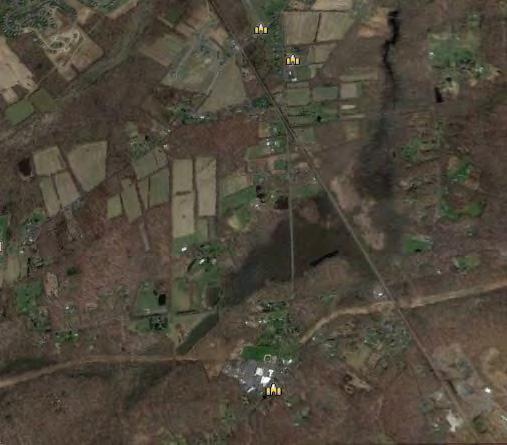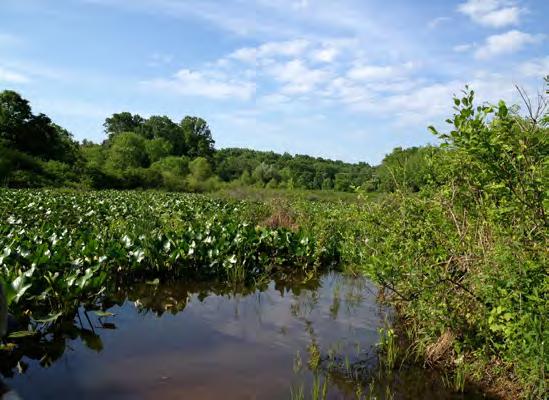
4 minute read
Wetlands of Distinction
Pennsylvania’s Quakertown Swamp
By Roy Messaros, U.S. Army Corps of Engineers
Quakertown Swamp is located within the Delaware River watershed in Richland, East Rockhill, and West Rockhill Townships, PA (Figure 1). It extends from the woodlands just west of Route 309 four and one half miles to the northeast to Tohickon Creek.
Quakertown Swamp is a 210-hectare natural wetland that is recognized as one of the most significant natural resources in Bucks County (Rhoads and Block 2011; Figures 2 and 3). The diversity of habitat includes open water along Bog Run, emergent cattail marsh, shrub wetlands, wet meadows, and other palustrine wetlands. Quakertown Swamp has long been recognized as an exceptional wetland habitat. Exemplary ecosystem services include floor storage, flood mitigation, water quality improvement, aquifer recharge, recreation (e.g., birding and ecotourism), and education. Quakertown Swamp was named by the Bucks County Planning Commission as an important wetland within the state (Heritage Conservancy 2000).
The Quakertown Swamp was approved as the 38th Wetland of Distinction for its pristine characteristics and wetland functions and values that include supporting high bird diversity as well as critical wildlife habitat for many amphibians and reptiles. Among the various species of amphibians and reptiles supported by this wetland are five species of turtle, seven species of frog, three species of salamander, and
five species of snake. “We were very pleased to receive and approve the application for the Quakertown Swamp as a Wetland of Distinction,” said Jason E. Smith, PWS – Co-Chair of the Wetlands of Distinction Committee for the Society of Wetland Scientists (SWS). Jason commented further that the “Long-term protection of such valuable wetlands will depend on recognition and support by the public, especially those who surround and benefit the most from preservation and protection efforts.” According to the Pennsylvania Natural Diversity Inventory, it is one of the largest intact, inland wetlands in southeastern Pennsylvania and is exceptional for its broadleaf deciduous shrubs and excellent bird habitat (Heritage Conservancy 2020). Dominant flora include red maple (Acer rubrum), pin oak (Quercus palustris), swamp white oak (Quercus bicolor), black willow (Salix nigra), buttonbush (Cephalanthus occidentalis), and tussock sedge (Carex stricta). The Quakertown Swamp is especially known for providing extensive habitat for 74 species of nesting birds including 14 rare breeders, eight Species of Special Concern, and four of uncertain nesting status (Figure 4). The Swamp is the only known nesting area of the Sora Rail (Porzana carolina) and Marsh Wren (Cistothorus palustris) within in this region (Heritage Conservancy 2000). Quakertown Swamp occurs entirely within the Quakertown diabase sheet which is an igneous rock formation of the Jurassic period that FIGURE 1. Symbol showing general location of Quakertown Swamp, Pennsylvania, USA. (Source: Google Earth). intruded into the Triassic sedimentary shales and sandstones to form a series of subsurface sills and ledges which have subsequently been exposed by erosion. Regions such as this would typically have large surface rock but the region’s wetlands allow for sediment accumulation and accelerated weathering of the underlying rock due to frequent inundation followed by periods of drawdown. An interesting
FIGURE 2. Overview of the Swamp. (Source: Google Earth; April 2014 image.)

FIGURE 3. Quakertown Swamp. (Photo courtesy of James Drennan.)

FIGURE 4. Scarlet Tanager (Piranga olivacea) is a high priority conservation species in Pennsylvania and one of many birds of special significance breeding in Quakertown Swamp. (Photo courtesy of James Drennan.) feature of this region is shallow, nearly flat valleys with slow-moving streams that spread out to form extensive wetlands. Quakertown Swamp is the largest of these valley wetlands within Bucks County. Similar wetland areas occur along Butter Creek, Dimple Creek, and Ridge Valley Creek but are all smaller in size. The soils of Quakertown Swamp are primarily Hatboro silt loam, a floodplain soil formed from alluvium washed from the surrounding uplands (Heritage Conservancy 2000).
Quakertown Swamp is unique and therefore offers much value to the local community. The Pennsylvania Game Commission recognizes this extensive swamp as significant habitat for nesting and migrating waterfowl. Quakertown Swamp is listed by the U.S. Fish and Wildlife Service as an important wetland area in Pennsylvania. The Bucks County Planning Commission named Quakertown Swamp as a significant natural area in its natural resources plans (1986 and 1999) and in its Natural Areas Inventory (1999). Quakertown Swamp has been designated by Pennsylvania Audubon as Important Bird Area (Heritage Conservancy 2000) with breeding colonies of Least Bittern (Ixobrychus exilis), Marsh Wren (Cistothorus palustris), Black-crowned Night-Heron (Nycticorax nycticorax), and Great Blue Heron (Ardea herodias). Other species of note include Sora (Porzana carolina), Virginia Rail (Rallus limicola), and Common Snipe (Gallinago gallinago).
Decades of partnerships and support from caring community members have made it possible for the Quakertown Swamp to flourish despite adversity from development. Residential land development within and surrounding area had been significant making it essential to protect areas to sustain this region. Fragmentation by land development remains a significant threat to the Swamp’s health. Heritage Conservancy, a local non-profit natural resource conservation organization, has been instrumental in protecting the Swamp. The mission of Heritage Conservancy is to preserve and protect the natural and historic legacy of local ecological habitat of over 6050 hectares which includes Quakertown Swamp of which it owns 28 hectares. Heritage Conservancy is proud that the Swamp has achieved designation as a Wetland of Distinction. This recognition sends a message to everyone that the Quakertown Swamp is a significant natural resource and deserves protection. n
REFERENCES

Heritage Conservancy. 2000. Preserving and protecting our natural and historic heritage. https://www.heritageconservancy.org Heritage Conservancy. 2020. Quakertown Swamp designated as a ‘Wetland of Distinction’. Path, Doylestown, PA. https://patch.com/pennsylvania/doylestown/quakertown-swamp-designated-wetland-distinction. Rhoads, A.R. and T.A. Block. 2011. Natural Areas Inventory Update, Buck County, PA. 465 pp.







